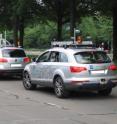Coordinated avoidance maneuvers
A child runs across the street without paying attention to the traffic, just as a car approaches at speed. It's too late to slam on the brakes, and the driver can't swerve either, as there is another car on the neighboring lane. An accident seems inevitable. A new software program, that for the first time can help several cars to coordinate their movements together, could take the edge off such a situation in future. The vehicles form a network via car-to-car communication and communicate automatically. "In dangerous situations, the cars can independently perform coordinated maneuvers without their drivers having to intervene. In this way, they can quickly and safely avoid one another," explains Thomas Batz, who developed the software together with his colleagues at the Fraunhofer Institute for Information and Data Processing IITB in Karlsruhe and at Karlsruhe University 's chair for interactive real-time systems. For this system, the researchers are making use of cognitive automobiles that are autonomously driven for short periods of time. The vehicles are equipped with car-to-car communication and integrated sensors such as cameras, GPS and radar systems so that they can autonomously recognize their surroundings and avoid any potential obstacles. The vehicles form cooperative groups that can act in unison. These groups are made up of cars that are traveling in the same direction and are in radio range of one another. Since their speeds and destinations vary, they are constantly re-grouped. Every vehicle in a group automatically transmits its current position and driving situation to a car that has been designated as the group coordinator. This car gathers the information from all the other cars in its group and draws up a common relevant picture of the group's situation.
Sudden dangers, such as a child running onto the road, are recognized not only by the car directly affected but also by the group coordinator. If the car in question can neither brake nor swerve because there is another car on the lane to the right, the group coordinator steps in: It orders both vehicles to swerve to the right in a coordinated maneuver in order to avoid an accident with the child and a collision with one another. Unlike in current driver assistance systems such as the anti-lock braking system (ABS), control of the car is taken over automatically. The system is currently under development: Its group formation function has already been implemented, and the researchers are now improving its ability to recognize and assess dangerous situations and to choose appropriate driving manoeuvres.
Source: Fraunhofer-Gesellschaft
Other sources
- Accident Ahead? New Software Will Enable Cars To Make Coordinated Avoidance Maneuversfrom Science DailyMon, 3 Nov 2008, 15:28:21 UTC
